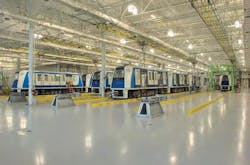Elevating Airport Conveyance To The Next Level With Automated People Movers
Demand for air travel is increasing. Larger aircraft are being deployed. Airports are more much expansive, both in size and scope, as well as annual passenger operations. All this makes it increasingly challenging for airline passengers to quickly and efficiently access key areas of the airport – terminals, gates, or baggage claim - which often involve traveling excessive distances.
Passengers today can navigate sprawling airports by various means depending on the distance that needs to be traveled. Whether by unassisted walking, using buses, moving walkways or airport people movers, the primary goal is to for air travelers to be able to easily and conveniently reach various airport locations within often limited transfer and connection times.
Ultimately, current and future passenger conveyance technologies need to keep pace with near-term increased travel patterns, and more importantly because demand will continue to escalate, they need to be a part of the overall solution for airport mobility well into the future.
Today, airport people movers (APM) are in the mainstream of airport planning, design, and operation because they are recognized as an acceptable and effective technique for overcoming the large scale of high-capacity airports and making them more efficient and accessible.
Many national and international airports are already utilizing APMs as viable conveyance solutions when planning infrastructure upgrades and future modernization programs. As the industry moves towards developing a seamless intermodal transportation system, airport planners are looking towards making use of people movers that can offer both short and long-term benefits for travelers and operators.
Based on HNTB’s extensive experience planning and designing automated people mover systems, here are a few key planning and development considerations.
To determine whether APM technology is an appropriate and viable conveyance method to consider, a disciplined evaluation and needs assessment and feasibility study has to be carried out in light of the airport’s overall master plan.
The process of planning and implementing an airport automated people mover is complex and infrastructure and equipment requirements are costly investments. Goals and budgets are unique for every airport, and no matter the size and scope, airports will benefit from evaluating a variety of potential options. Strategic recommendations and decisions can only be made after careful analysis of the findings.
In general, APMs are a good choice at airports where widely separated facilities need to be connected for passenger convenience and access. Without conveyance systems, the long distances between airport terminals, parking and rental car facilities, and bus and regional intermodal centers, create conditions can put a strain on travelers.
As with any transportation option, timing is a key consideration and wait times and capacity need to be addressed. Unlike buses, APMs are automatically operated and can function with minimal wait times and more frequency, thus improving a passenger’s transit experience and perception of higher service levels.
Connecting airport passengers need to be able to move quickly between terminals and gates, so they don’t miss their flights. More often than not, walking is not a viable option because passengers must be able to travel to/from their gates, often with luggage, within reasonable times.
People movers that serve multiple functions – like car rentals, remote parking lots and connections to regional urban transportation – make passenger conveyance even more useful and convenient.
As part of Tampa International Airport’s master plan, HNTB’s recommended modernization and expansion plan includes a new consolidated rental car facility linked to the main terminal with an automated people mover, increasing accessibility for passengers between on and off-airport facilities.
At Washington Dulles International Airport, HNTB is designing a loop tunnel system that will ultimately allow a new automated people mover system to link all the airport’s terminals and concourses. The ten-mile, multi-tunnel project will also accommodate a new baggage handling system, underground tug tunnels, a utility tunnel and a pedestrian walk back tunnel.
APM systems in use today around the world provide high-capacity, good quality, and reliable travel options and have the ability to keep up with future growth and travel demand.
Airports and surrounding communities are increasingly becoming more interconnected and transit-oriented, and connectivity plays a role in ensuring an airport maintains its competitive position. More airports are transitioning into multimodal transportation hubs with regional connectors to rail systems that not only serve the airport but can transport passengers to central business districts, and closer to where they live and work.
In San Francisco, HNTB served as the principal designer for the Bay Area Rapid Transit’s (BART) eight-mile San Francisco Airport extension, which included design and construction of the San Bruno Station and South San Francisco Station as part of the eight-mile BART extension. Now, the BART/SFO extension continues to provide the greater San Francisco Bay Area with an efficient connection to the global transit network, and serves as a link to the rest of the world.
The integration of APMs, light rail, bus rapid transit and rail are poised to meet the changing demands of travelers for seamless transit.
When considering APMs, airport planners should also look beyond the numbers like forecasted and future traffic increases. They need to consider how travel behaviors are changing with the increased use of technology, automation and innovations that will have a significant impact on overall infrastructure needs in the future.
While many issues to consider are beyond the scope of this article, these are just a few key considerations can assist in the evaluation and decision-making process to ensure that major planned investments will ultimately result in meeting an airport’s goals for seamless mobility and an enhanced passenger experience.
With additional focus on developing train-to-plane solutions through the increased use of people movers, airports and travelers can both benefit. By managing the flow of passengers, reducing congestion and continuing to accommodate higher passenger volumes more efficiently, airports will be able to keep pace with the increased demand.
And for passengers, having a choice of well-coordinated transportation options in getting from their home to and through the airport can reduce journey time, be more comfortable and convenient, and as a result, increase overall passenger satisfaction.
Peter Aarons is West Division aviation director and associate vice president for HNTB. He has more than 25 years of experience in planning, development, design, program and project management, and construction for airports. Contact him at [email protected]. HNTB was recently ranked as the No. 1 airport design firm in Roads & Bridges magazine’s 2014 Go-To List, as preferred by the publication’s readers. The firm’s many signature aviation projects include design of the “Green Build” expansion at San Diego International Airport; engineering and design services at Los Angeles World Airports; and Hartsfield-Jackson International Airport South Concourse development APM system.


